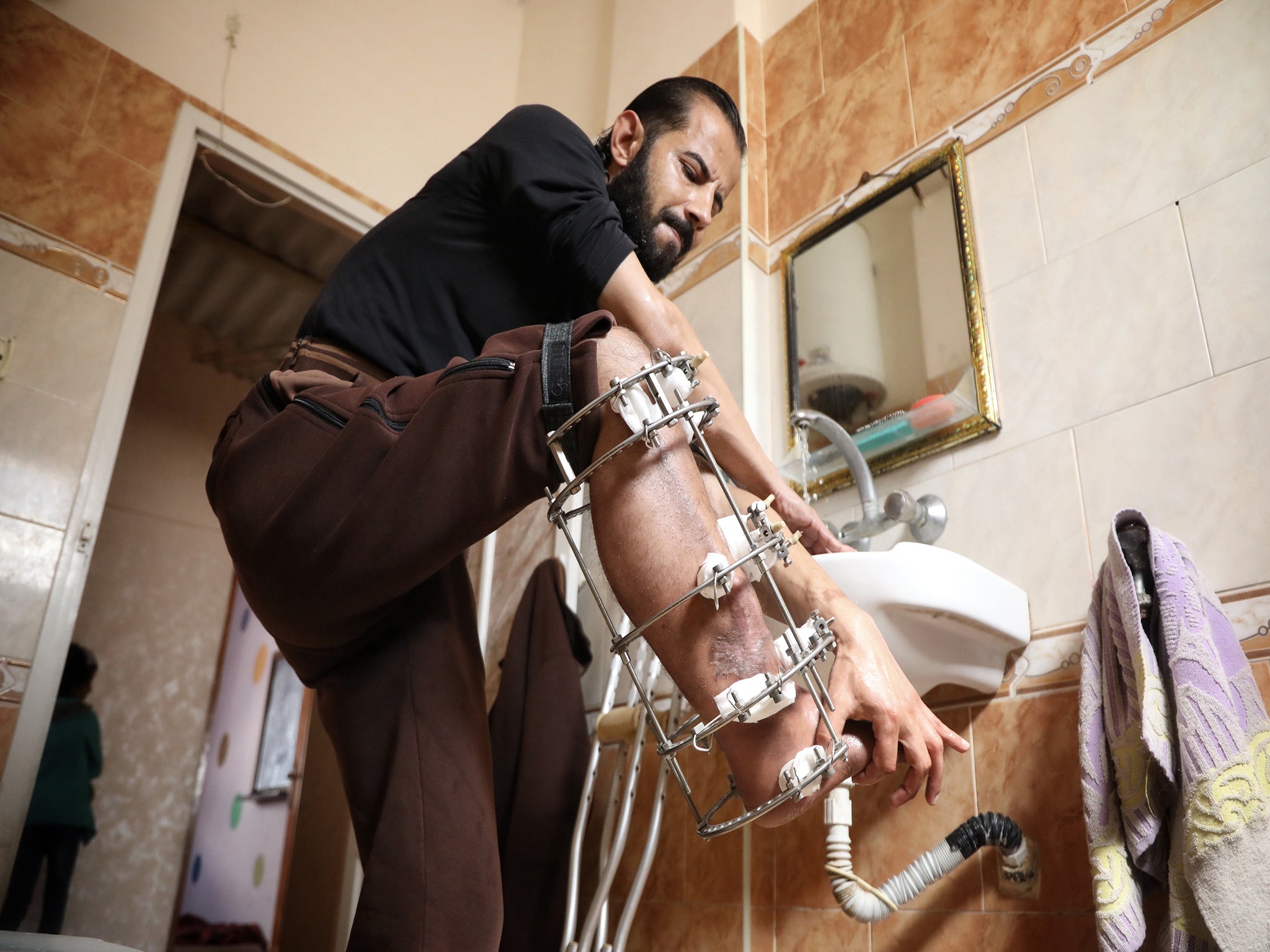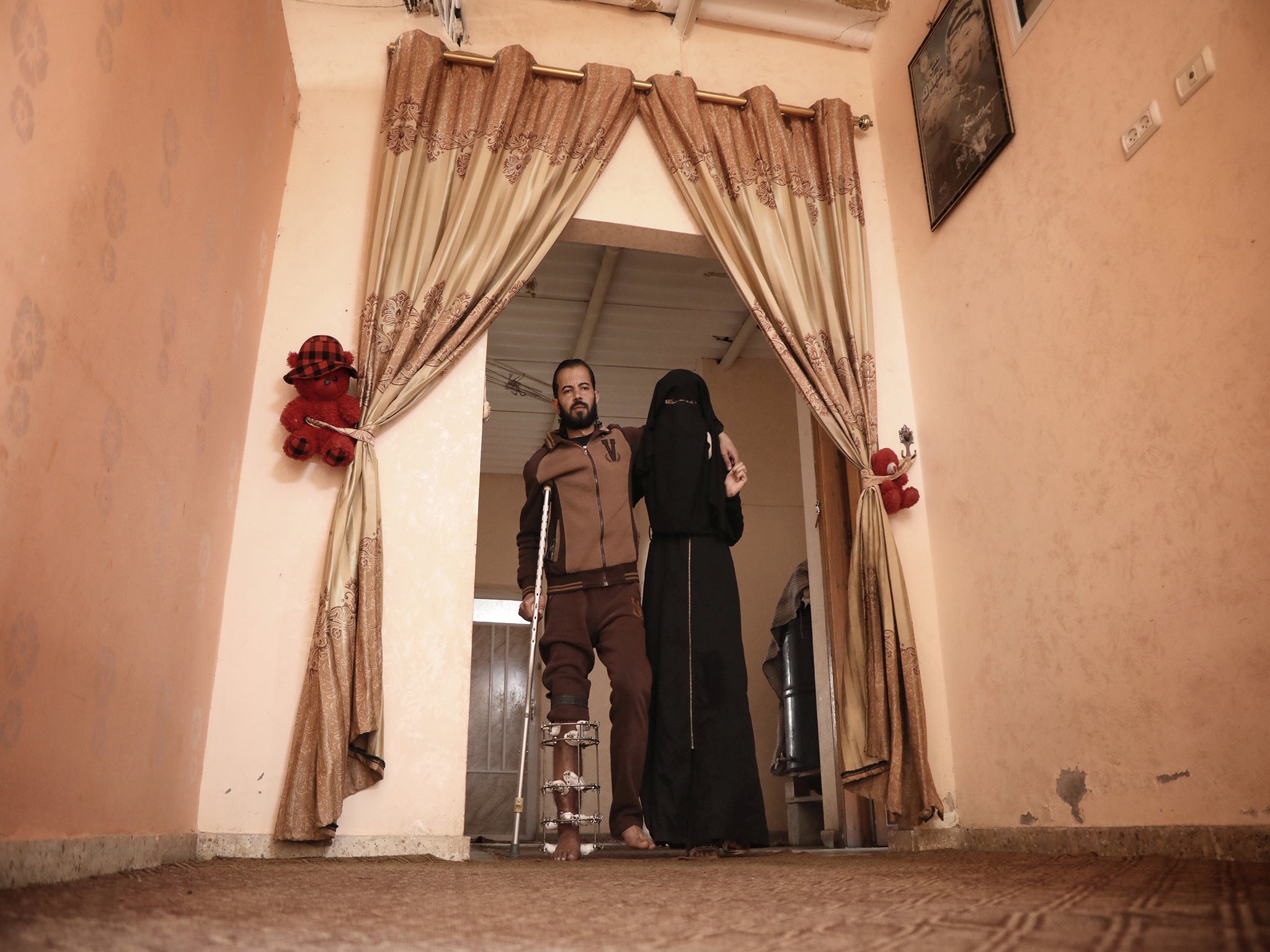Gaza protests: hope fades as weekly border clashes bring more carnage than change
Hamas has pressured Israel into loosening restrictions on international aid, but for what they’ve received, they’ve paid in blood, writes Loveday Morris

Mohammed Mikdad used to spend his Friday afternoons at the fence that runs along Gaza’s border, taking part in weekly demonstrations against Israel. They were fun, he says, and he didn’t have much else to do.
But after being shot in the leg by an Israeli sniper in May, Mikdad, 35, has spent recent Fridays begging outside the local mosque, unable to continue his work as a doorman and struggling to support six children and service his debts.
“We hoped it might make a little change. Later, I discovered it was worthless,” he says, his leg secured in a metal apparatus that he adjusts every six hours to help mend his shattered bone.

Every week for the past year, Palestinians have massed at the fence to demonstrate in the March of Return. For Hamas, the militant group that controls Gaza, the protests have become a tool to pressure Israel into softening restrictions on the enclave, with limited success.
The tangible rewards for Gaza’s 2 million residents have been modest. Hamas secured a temporary deal under which Israel allowed the injection of Qatari funding into the territory to pay for salaries and fuel. Youth unemployment, however, stands at 65 per cent, poverty is widespread and disillusionment with both the demonstrations and Hamas is growing among a population who have paid with their blood.
“We have achieved something, but it’s not a lot and it is much less than expected,” says Basim Naim, who heads Hamas’s international relations office. “If we compare the achievement to the price, we’ve paid a very high price.”
If we compare the achievement to the price, we’ve paid a very high price
Since the demonstrations began last year, 256 Palestinians have been killed, including 49 under the age of 18, according to health authorities in Gaza, the majority shot by Israeli sharpshooters. An additional 6,850 have suffered gunshot wounds – more than 130 people each week on average.
Israeli officials have said lethal force is necessary to protect the fence and prevent Palestinians from potentially attacking Israeli communities on the other side. Israel accuses Hamas, which the United States and Israel consider a terrorist group, of using demonstrations as a cover for attacks.
Desperate to deliver better living conditions and deflect mounting frustrations, Hamas has again tried to ramp up pressure on Israel in recent months, analysts say. The Palestinians have sent more than a dozen incendiary balloons across the border into Israel, an activity Hamas had agreed to stop. A rocket, which the Israeli military says was launched by Hamas, struck a house near Tel Aviv in March, triggering Israeli airstrikes on Gaza and more rocket volleys from the enclave. The hostilities highlighted the potential for violent escalation ahead of Israel’s elections.
For Hamas, the protests have produced some room to breathe. A year ago, analysts speculated that if Hamas felt compelled to divert the building pressure it faced in Gaza, it could spark a new war with Israel.
“The situation in January 2018 was very, very dangerous and explosive,” says Naim. “There were three scenarios: either to explode externally, with escalation and a new war with the Israelis; accepting the situation, which I’ve always described as dying in silence; or the third scenario, which we explode internally.”
Over the past year, in an effort to squeeze its rival Hamas, the Palestinian Authority axed the pay of thousands of salaried workers in Gaza, draining millions from the economy and adding to the misery caused by more than a decade of tight Israeli restrictions on the movement of people and goods in and out of the territory.
Mikdad had been a soldier for the Palestinian Authority, controlled by the Fatah party, before it was ousted from power in Gaza when Hamas won elections in 2007. He saw his pay drop from £420 a month to £290. Mahmoud Abbas, who heads the West Bank-based Palestinian Authority, also cut payments for electricity in Gaza, which resulted in extensive power outages and put its sewage-treatment plant out of operation. Raw sewage flowed into the sea.

In the meantime, Israel tightened restrictions and, among other things, drastically reduced permits for businesspeople to enter and leave Gaza.
So when young activists began to rally around the idea of demonstrations at the fence, Hamas ran with it. Naim says young people need to be reminded of the root of their problems: Israel.
Hamas officials say the protests succeeded in putting the Palestinian issue back on centre stage. They also contributed to the temporary deal, under which Qatar provided £7.5m for salaries, £7.5m for the power station and £3.8m for a cash-for-work project. Israel has extended Palestinian fishing rights, and Egypt has opened its border crossing for Gazans to leave the enclave.
“It doesn’t solve the problem; it’s a painkiller,” Mkhaimar Abusada, a political science professor at Gaza’s al-Azhar University, says of the deal.
Egypt is trying to broker a deal with Israel that would allowing funding for water and electricity-infrastructure projects in exchange for calm, but the efforts by Egypt to broker a longer-term understanding have stalled.
Patience in Gaza is running thin, says Abusada.
In recent weeks, Palestinian protests have broken out on the streets, this time against Hamas. The group has brutally suppressed demonstrators, using live ammunition and beating them with batons. Rights groups estimate that about 150 people have been injured, and detainees number in the hundreds.
Journalists covering the demonstrations also were beaten, arrested and had their equipment seized.
“I think this is a litmus paper to understand how nervous Hamas is,” says retired Israeli colonel Michael Milstein, who served as an adviser on Palestinian affairs with the Israeli army.
This popular discontent is the only release the group has, he says, which makes it improbable that Hamas will be able to wind down the demonstrations along the fence.
The human toll is already overwhelming Gaza.
“The Palestinian people, more and more, don’t want to be fuel for an Israel-Hamas escalation,” says Abusada. “We lost so many young Palestinians that we have a discussion within our own community that enough is enough. Many injured don’t get the medical care they need, they end up in a miserable situation.”
Gaza’s overstretched health services have been unable to care for the vast numbers who have suffered gunshot wounds. Many required multiple surgeries.
Doctors Without Borders says it has treated more than 4,000 gunshot wounds over the past year in five clinics. Outside, young men with bandaged legs and crutches sit on the street.
“There’s a shortage of beds. The capacity to absorb more patients like this is more than challenging,” says Carla Melki, the organisation’s field coordinator for Gaza.
There’s a shortage of beds. The capacity to absorb more patients like this is more than challenging
Mohammed Abu Sharar, 22, was injured on 30 March, 2018. He says he was hit by a bullet about three minutes after arriving on the scene by bike “just to look”. He’s had 17 surgeries. “It’s pointless now to regret,” he says, his leg in a metal apparatus.
A United Nations commission of inquiry concluded last month that Israeli forces may have committed war crimes by opening fire on protesters, most of whom were unarmed and posed no immediate threat of death or serious injury to the soldiers when shot. It says 183 Palestinians were killed in the first nine months of the demonstrations.
The commission’s findings were rejected by Israel, which says it’s investigating 11 deaths on the border. Although the Israeli military has not fully disclosed its rules of engagement, officials say that the use of live ammunition can be warranted when protesters endanger the fence.
Israel now faces two bad options, says Milstein. The first is to broker a cease-fire deal with Hamas and help to stabilise Gaza, but that could strengthen Hamas. The second is to maintain or tighten restrictions on the territory, which could bring about the collapse of Hamas and leave Israel with the burden of taking care of 2 million Gazans, he says.
While Israel and Hamas have been trying to avoid an escalation into all-out war, that doesn’t mean it won’t happen, he added.
“The dynamic of everyday clashes and the Hamas attempt to channel its internal problems towards Israel, this can be a recipe for escalation, without plan or enthusiasm,” Milstein says.
The two sides moved dangerously close to war in recent months after the rocket from Gaza slammed into a house in central Israel, injuring seven people and forcing Israeli prime minister Benjamin Netanyahu to cut short a visit to the United States.
Hamas called for a march of “a million” to mark the anniversary of the protests. But the demonstrations, which have continued weekly, have lost the sense of hope and excitement of the early days when they drew a range of Gaza residents.
Still, each week, thousands of Palestinians go to the fence, including 18-year-old Mohammed Bourdaini, who comes despite having been injured four times. He was wounded in the face on the first Friday by shrapnel. On the fourth Friday, a bullet cut clean through his arm. Shrapnel nearly took out his eye the third time. Last time, a bullet hit his leg.

On a recent Friday, he made his way back from the border on crutches, a slingshot around his neck. His cousin, who was also shot in the leg, limped along beside him.
The confrontation has taken a toll on their family: eight members have been wounded over the past year.
“It’s achieved nothing,” says his uncle, who was injured by bullet fragments to the chest.
Bourdaini’s father was also shot two weeks ago – a bullet cut through both of his legs. Resting in a bed he cannot leave, he says, “The only thing I can find is that it made people pay attention.”
© Washington Post
Join our commenting forum
Join thought-provoking conversations, follow other Independent readers and see their replies
Comments
Bookmark popover
Removed from bookmarks